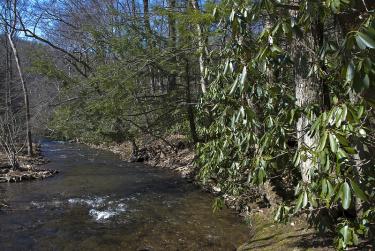More Steps to Take
A buffer of 200-300 feet around streams protects water quality.
- Promote the health of waterways and wetlands. Water is essential for all birds, for bathing, drinking and foraging. Having healthy water sources will help you attract all types of birds.
- Conserve and restore forests along streams and ravines. Woodlands along streams are important for migratory birds, as well as those that forage and nest exclusively in the forest cover along streams. Try to maintain a forest buffer of 200-300 feet around streams. In addition to supporting birds, the buffer zone will help maintain the health of the stream by preventing stream bank erosion.
- Reduce non-native, invasive plant species like kudzu, English ivy, and salt cedar. These invasive plants often out-compete or kill native plant species that provide important resources for native birds. Keeping them in check is an important element of maintaining a healthy forest.
- Avoid the use of pesticides and herbicides. Chemical weed and insect controls can poison waterways and food sources for birds, as well as posing hazards to people and pets. An estimated 7 million birds die annually due to the use of pesticides on lawns.
- Keep cats indoors.Domesticated cats kill hundreds of millions of birds in the U.S. annually. One important way to ensure birds can live safely in your woods is to keep cats inside. If you know there are feral cats in your woods, you can help protect birds by planting plenty of good ground cover and providing brush piles for birds to hide in.
Protect birds: keep cats indoors.
- Help birds see windows. If you have glass surfaces on your land, help birds avoid collisions by installing screens, closing curtains when you are not home (especially if they are light colored), and using other methods that help birds identify glass surfaces. It is estimated that 1 billion birds die annually in the United States alone from running into windows.
- Support celestial navigation! Many migrating birds use the stars as waypoints. But when there are distracting electronic sources of light, birds can be thrown dangerously off course. You can aid bird travelers by turning off interior and exterior lights when they are not in use.
Previous page
Next page
How can I get more tips?
It’s simple! Enter your email below.


